September 2022
September 12, 2022
Dead Bird Decoy Holder
When a wooden or plastic decoy just won't do!Full patent here.
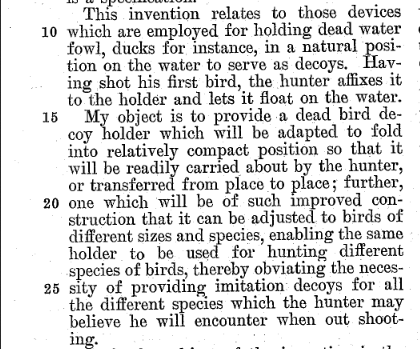
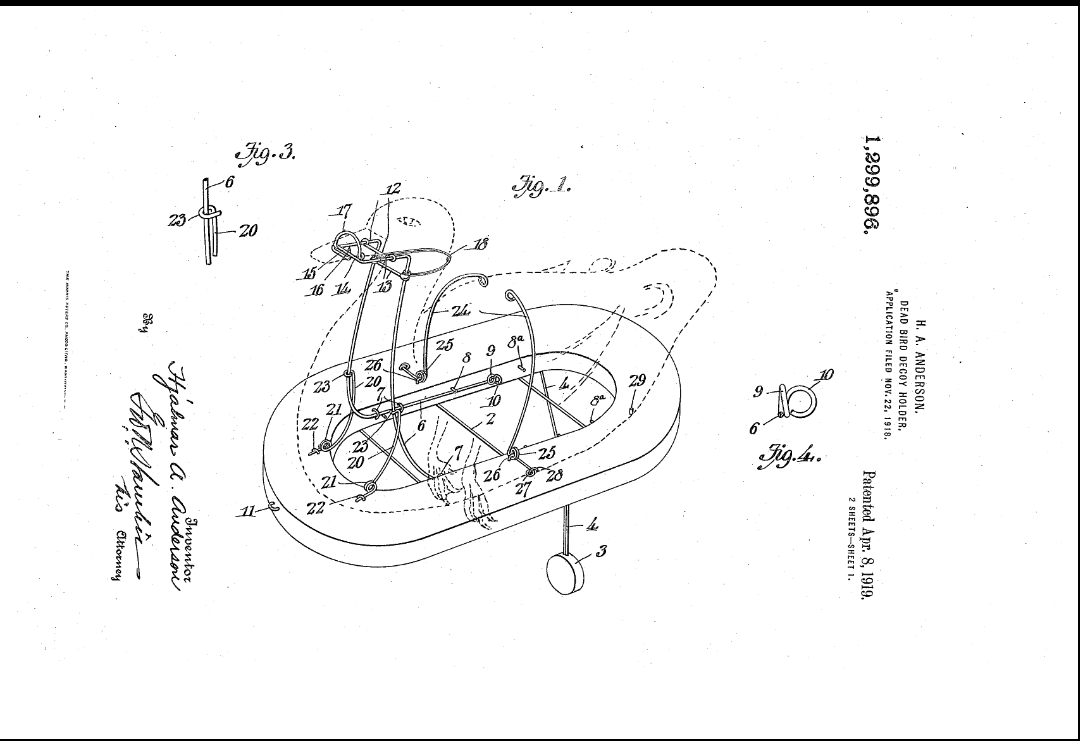
Posted By: Paul - Mon Sep 12, 2022 -
Comments (0)
Category: Animals, Hunting, Trapping and Other Wilderness Activities, Imitations, Forgeries, Rip-offs and Faux, Patents, 1910s
September 11, 2022
Bees told of Queen Elizabeth’s Death
Royal housekeeper John Chapple has carried out the duty of telling the bees kept at Buckingham Palace and Clarence House that Queen Elizabeth has died, and that King Charles is their new master."You knock on each hive and say, 'The mistress is dead, but don't you go. Your master will be a good master to you.'"
This was in accordance with the ancient British custom of "telling the bees," which we described in a post back in 2012.
More info: geo.tv
Posted By: Alex - Sun Sep 11, 2022 -
Comments (2)
Category: Animals, Customs, Death, Royalty, Superstition
Mindfork
b'Mindfork', b'Catherine' b'Dubeau', provided by the National Film Board of Canada
Posted By: Paul - Sun Sep 11, 2022 -
Comments (0)
Category: Surrealism, Cartoons, Twenty-first Century, Mental Health and Insanity
September 10, 2022
Miss Stainless Steel Wire
In addition to winning the non-glamorous title of Miss Stainless Steel Wire, Claire Dennis was named Miss Photoflash of 1949. She managed to leverage the publicity from that award into a small role in the 1950 film The Petty Girl. After that, her career as a model/actress seems to have ended.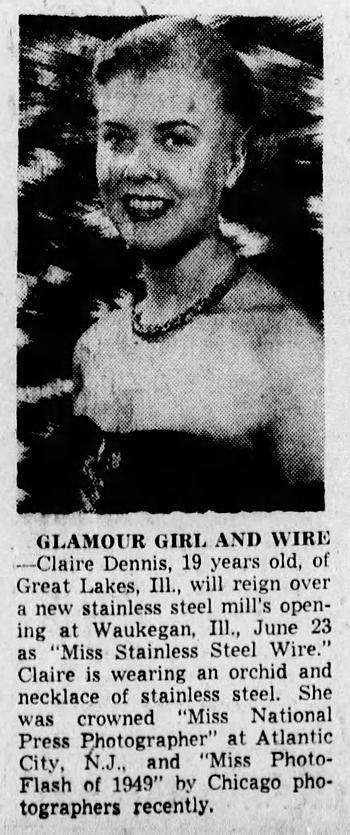
Indianapolis Star - June 9, 1949
Posted By: Alex - Sat Sep 10, 2022 -
Comments (0)
Category: Awards, Prizes, Competitions and Contests, 1940s
The Hypnotic Powers and/or Memory-wiping Drugs of Cool Whip
Posted By: Paul - Sat Sep 10, 2022 -
Comments (0)
Category: Family, Hypnotism, Mesmerism and Mind Control, Money, Propaganda, Thought Control and Brainwashing, Advertising, Junk Food, 1970s
September 9, 2022
Space Boots
Released by Ideal Toy Corp. in 1969:"space boots of adjustable molded air cushions so that the child can experience the floating feeling of walking on the moon."

source: awmok.com
Posted By: Alex - Fri Sep 09, 2022 -
Comments (3)
Category: Spaceflight, Astronautics, and Astronomy, Toys, Shoes
5000 Hedgehogs Needed
I do not believe this mystery has ever been definitively solved.Source of first clipping: The Guardian (London, Greater London, England) 07 Oct 1935, Mon Page 7
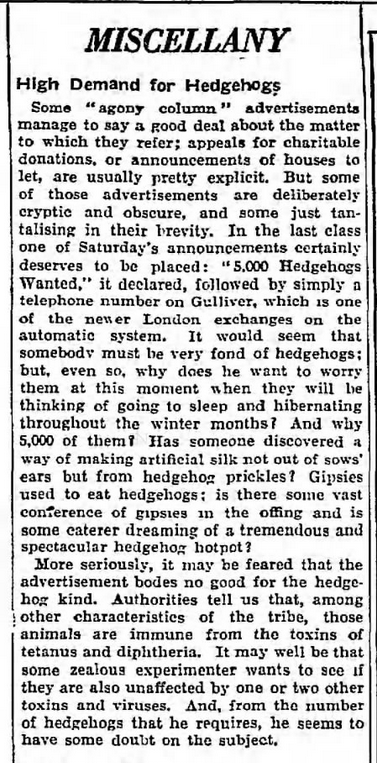
Source of second clipping: The Guardian (London, Greater London, England) 09 Oct 1935, Wed Page 9
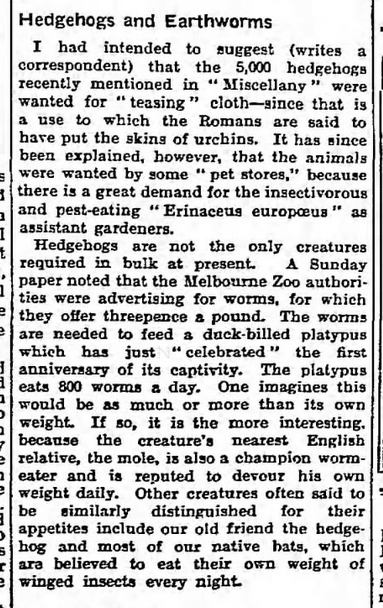
Source of third clipping: Western Morning News (Plymouth, Devon, England) 05 Jan 1937, Tue Page 4
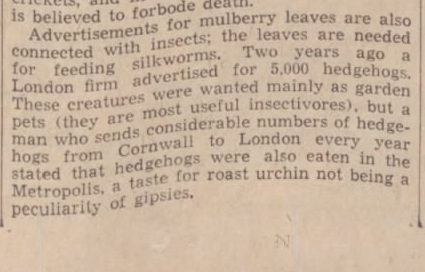
Posted By: Paul - Fri Sep 09, 2022 -
Comments (1)
Category: Animals, Unsolved Mysteries, 1930s, United Kingdom
September 8, 2022
Jaw Winking
In his 1973 book Thick Description, the anthropologist Clifford Geertz used the example of winking versus twitching to explain what it is that anthropologists should strive to do.An eye twitch and a wink can look identical. But a wink, Geertz explained, is an intentional signal. "To wink is to try to signal to someone in particular, without the cognisance of others, a definite message according to an already understood code." A twitch, on the other hand, is not intentional. It's not meant to convey meaning.
The job of the anthropologist, Geertz argued, was not merely to record facts and events (such as that a person's eye moved) but to be able to interpret the cultural meaning of those events. To be able to differentiate a wink from a twitch.
With that in mind, consider this story reported in the Miami Herald (Apr 30, 1939) about a young man whose eye twitches were constantly misinterpreted:
Such a case was reported some years ago by Dr. Francis C. Grant, an eminent neurologist of Philadelphia, Pa. He had a patient—a young man—whose left eye continually winked every time he sat eating at a table.
Whenever this youth dined in a restaurant, his jaws worked sidewise while chewing food. This caused his right jaw muscles to tug at the muscles controlling his left eye, so that every time he chewed his left eye seemed to wink.
Girls believed the youth was flirting with them. They responded, if flirtatious, or, if not, complained to the manager. In either case, the youth was embarrassed by his muscular malady.
Finally, he was compelled to eat alone at home. He was on the verge of becoming a hermit when he decided to consult Dr. Grant. Examination revealed the "short circuit" cause of his strange "jaw wink" and an operation was performed. The muscles, restored to normal action, ended the distressing condition and the youth could eat normally thereafter.
What I find odd is that I came across these two bits of information (first about Geertz, and second about the jaw-winking young man) while reading completely unrelated texts on back-to-back days. A strange coincidence!
You can read more about Geertz's thoughts on winking and twitching here.
You can read more about 'jaw winking' (aka Marcus Gunn Syndrome) at rarediseases.org.
Posted By: Alex - Thu Sep 08, 2022 -
Comments (1)
Category: Synchronicity and Coincidence, Eyes and Vision
Texaco Toy Tanker
Embrace your large carbon footprint with a model tanker ship!
Posted By: Paul - Thu Sep 08, 2022 -
Comments (1)
Category: Kitsch and Collectibles, Oceans and Maritime Pursuits, Toys, 1950s, 1960s, Power Generation
September 7, 2022
The Pain Performances of Gina Pane
French artist Gina Pane conducted "pain performances" that involved (as wikipedia puts it) "extreme self-inflicted injury." Some info from an article by Pawel Leszkowicz:Some of her pain performances:
Non-Anaethestized Climb (1971): Barefoot, she climbed up and down a ladder-like structure whose rungs were studded with sharp metallic shards. She did this until she was bleeding profusely.

Food/TV News/Fire (1971): While watching news footage of the Vietnam War, with a bright light shining in her eyes, she ate raw ground beef, and later threw it up.

Sentimental Action (1973): Dressed in white, she entered the gallery with a bouquet of roses, removed the thorns from them, and pierced her arm with the thorns. She then began cutting herself with a razor blade, allowing the blood to drip onto the roses.

Conditioning (1973): She lay on a metal bedframe position over two rows of burning candles. She later confessed that the pain started right away and was difficult to master. The audience could see the pain she was in by the intense wringing of her hands.

More info: art moderne
Posted By: Alex - Wed Sep 07, 2022 -
Comments (2)
Category: Performance Art, 1970s, Pain, Self-inflicted and Otherwise
| Get WU Posts by Email | |
|---|---|

| Who We Are |
|---|
| Alex Boese Alex is the creator and curator of the Museum of Hoaxes. He's also the author of various weird, non-fiction books such as Elephants on Acid. Paul Di Filippo Paul has been paid to put weird ideas into fictional form for over thirty years, in his career as a noted science fiction writer. He has recently begun blogging on many curious topics with three fellow writers at The Inferior 4+1. Chuck Shepherd Chuck is the purveyor of News of the Weird, the syndicated column which for decades has set the gold-standard for reporting on oddities and the bizarre. Our banner was drawn by the legendary underground cartoonist Rick Altergott. Contact Us |

